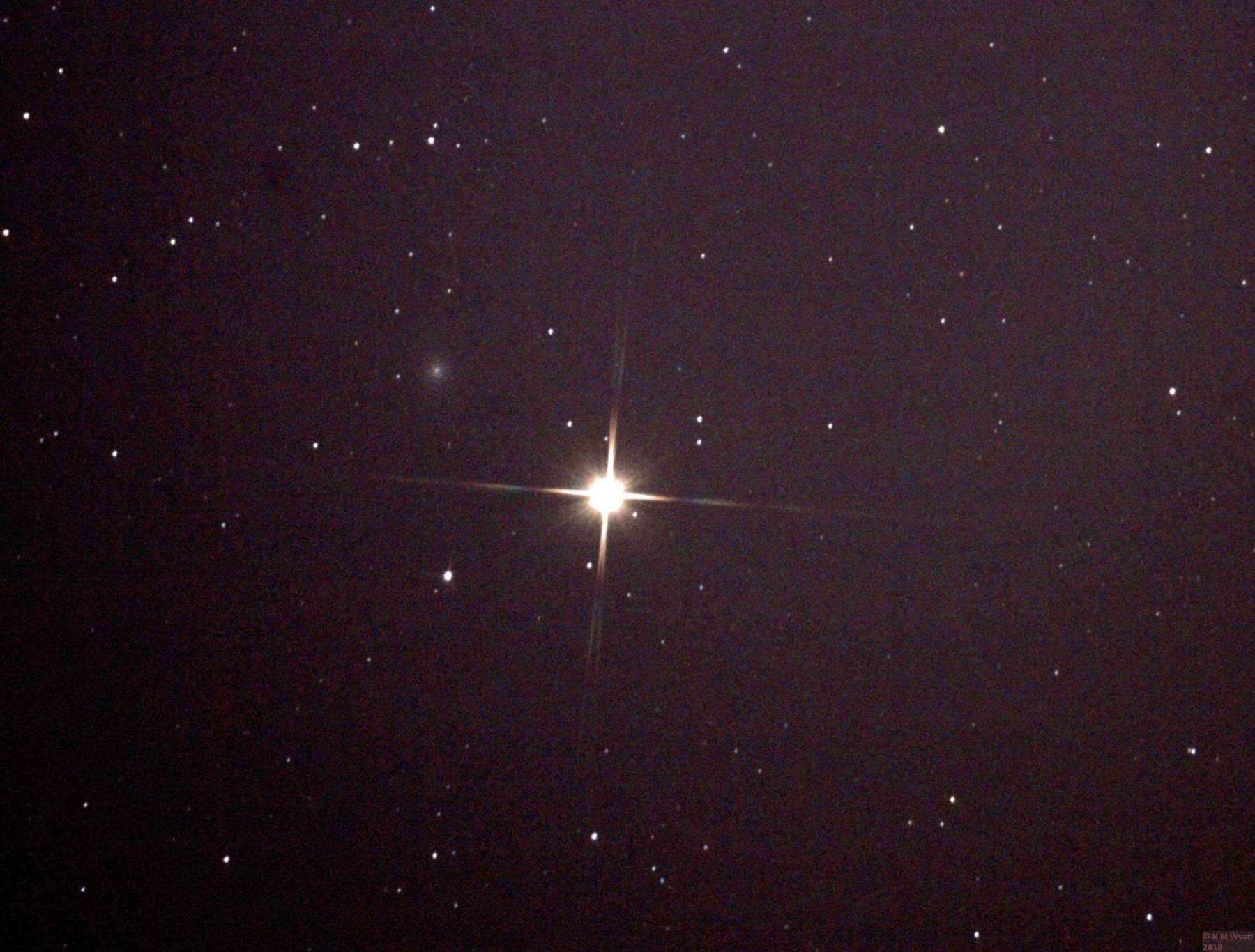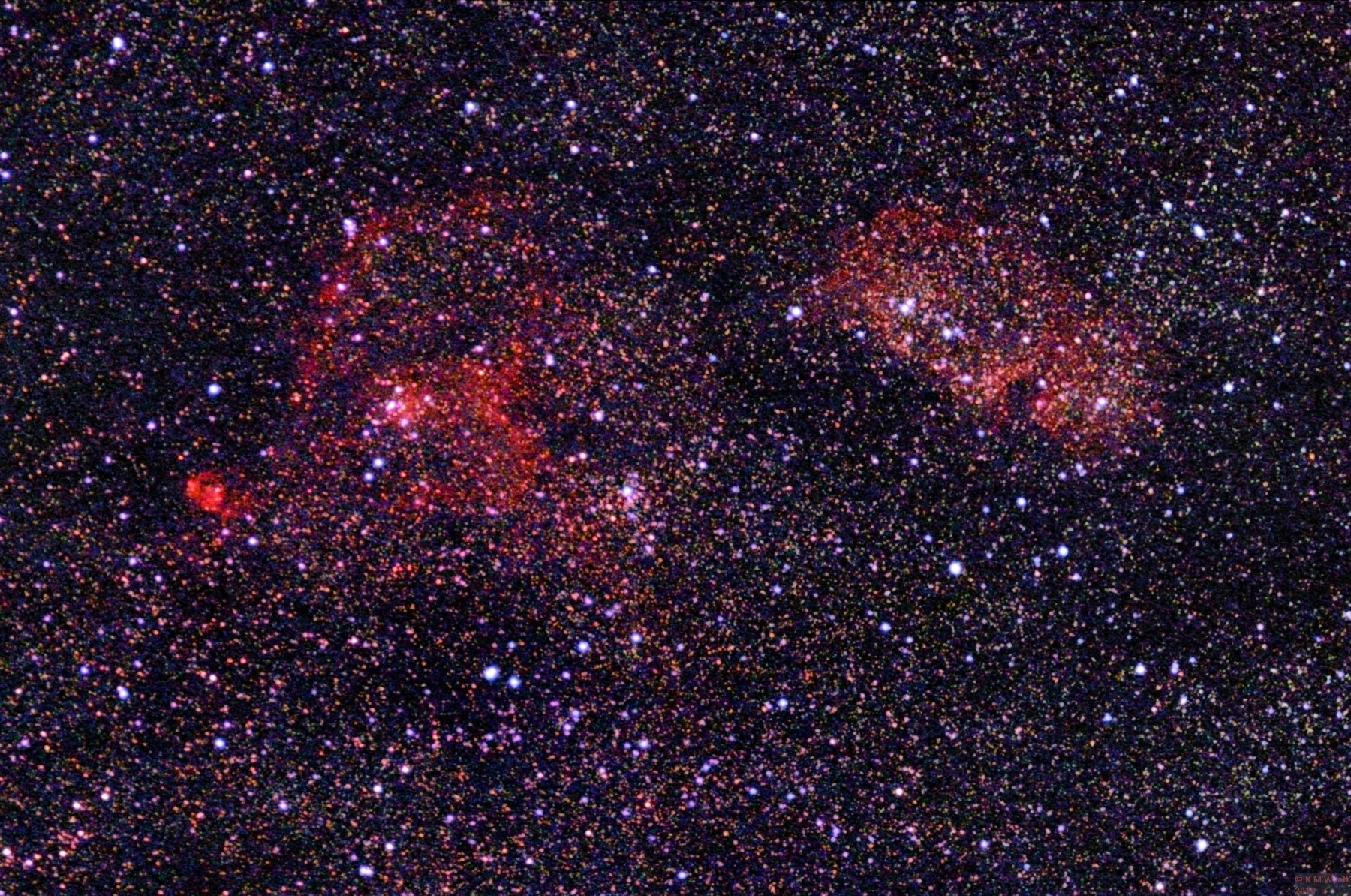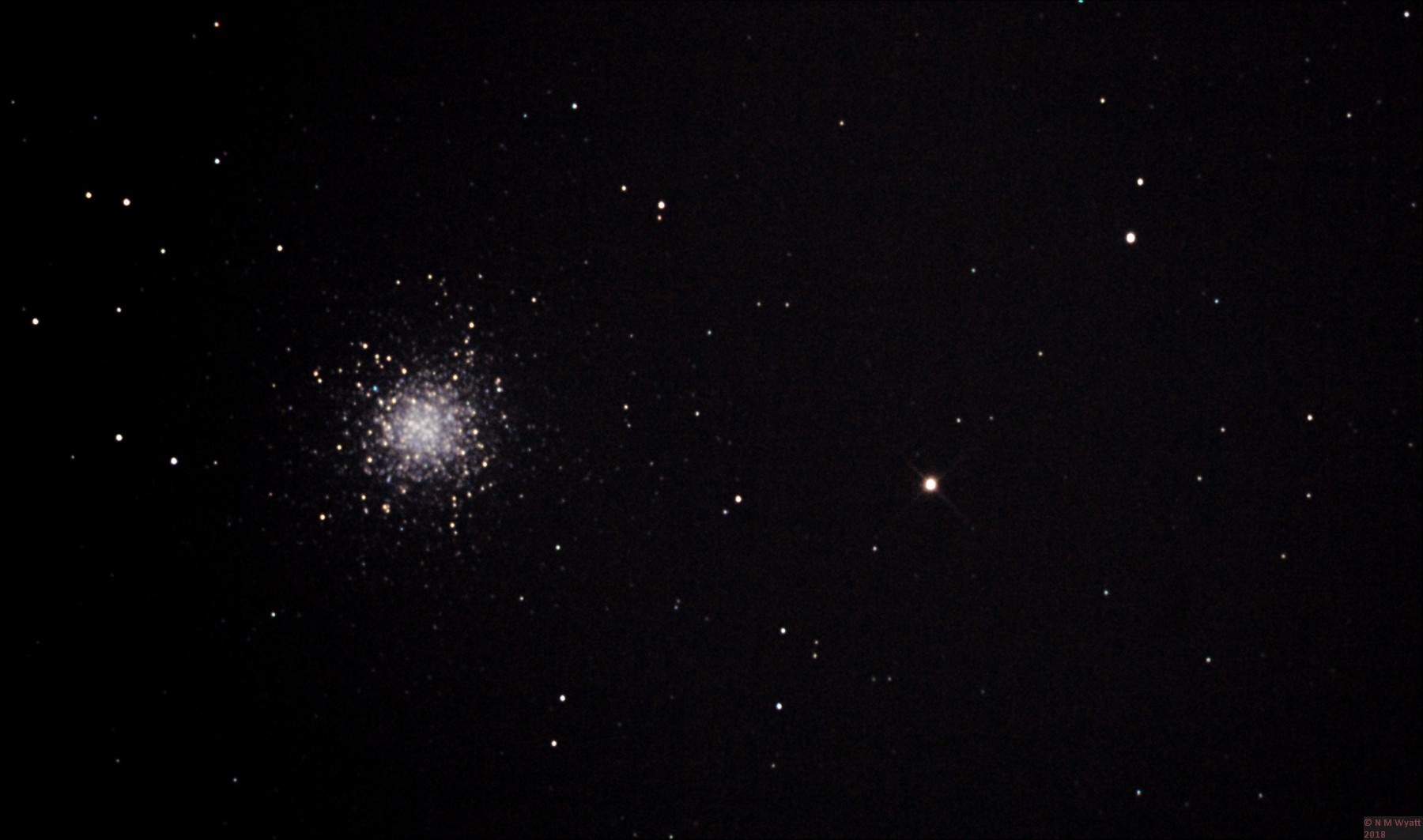If you find this website useful, please check out my books or visit my Amazon Author page. Or even Buy Me a Coffee!
Astronomy
Astrophotography
You are never too old to learn, and one of the thing that has opened my eyes has been discovering the quality of astronomical images that can be produced by amateurs with very modest equipment. By using digital cameras and image processing software it's a realistic ambition to produce images that compare favourably with those produced by the world's biggest telescopes fifty years ago - right in your back yard!
This website does not showcase the best astronomical pictures on the internet! It's a selection of pictures I have taken myself with basic equipment and free software. Producing images like these below, or even better ones, is within your reach!
Most importantly, you don't have to spend a fortune. My first serious scope, mount and tripod cost £180 on Ebay. I spent £40 on a more solid tripod, and about £200 on various bits and pieces including books and an ancient Canon EOS DSLR and a seconhand Microsoft HD Webcam. The results shown before are some of my best so far, and will be updated from time to time.
Perhaps the easiest target in the sky is the moon. You can get good pictures with any long or zoom lens, this is a 'stack' of six pictures taken with an ordinary bridge camera:
A gibbous moon photographed on the isle of Skye.
Follow the links below for introductions to some of the other things you can image in the night sky:
A Conjunction of Moon and Venus
Look into the night sky at a nice, dark site and you will see a glowing band that, if it is a truly dark site, appears to pass right across the sky. Known by the clumsy name of the Milky Way this is the view across the disk of our own galaxy.
The Milky Way
Look at the Milky Way through a telescope and the sheer number of stars on view can be overwhelming. This is the Milky Way near Cygnus, and although light cloud has affected the picture you can see how the whole view is full of stars. The slightly darker patch running diagonally down from top right is the 'Great Rift' where a cloud of cold, dark gas and dust is masking part of the Milky Way.

The Milky Way near Cygnus
Andromeda Galaxy, M31
The Andromeda Galaxy is our nearest neighbour in intergalactic space that isn't part of or orbiting the Milky Way. It is a huge spiral galaxy with two smaller galaxies gravitationally bound to it. To the naked it can be seen in dark skies as a fuzzy spot between Andromeda and Cassiopeia. You should be able to see that although it appears like a dim star, it is more 'spread out' than a star.
To the naked eye, the Andromeda Galaxy is just a fuzzy spot
Turn a telescope on Andromeda, and it is transformed. In a really dark sky it becomes obvious that it is several times the size of the full moon, and its companion Galaxies appear.
This photograph only covers about the central one-third of the Andromeda Galaxy, Messier Object number M31.The faint dark lines above the core are dust lanes, just like the Great Rift. The 'fuzzy blob' at bottom right is galaxy M32, M101 is outside this picture.
The central part of the Andromeda Galaxy (M31) also showing Galaxy M32
This second shot shows M32 and M110. The image has rather more detail as it is comprised of 66 80-second exposures taken with a 400mm lens and stacked in DSS.

A wider view of the Andromeda Galaxy. Satellite galaxies M32 and M101 are also in shot.
The Pinwheel Galaxy, M101
My personal ambition is to photograph other galaxies, but to do this successfully for fainter galaxies than M31 really means I need to improve my tracking. But though galaxies are faint, they aren't necessarily small - this is the Whirlpool Galaxy M101 above the tail of the Great Bear, it covers an area of sky about half as wide across as the full moon! You can see how much I have had to over-process this shot, but at least the spiral galaxy has been captured. But that's the best thing about astrophotography - even basic kit can get you rewarding results, but there is always something out there to stretch your abilities and equipment to the limit!
The Pinwheel Galaxy, M101, a stack of 30-second images at ISO 1600, longer subs will bring out more detail!
MIrach's Ghost
Mirach is a star in the constellation of Andromeda. A typical star chart will show a small object 'overlapping' Mirach, but actually this is a dwarf galaxy, NGC404 that is slightly to one side of Mirach and rather further away. Mirach's Ghost is actually a 'dwarf galaxy circuiting our own galaxy like the two Magellanic Clouds visible in the southern hemisphere, but further away. I did rather better with this than M101 and was pleased to capture a somewhat difficult object.
Mirach's Ghost, NGC404, is the small fuzzy up and to the left of bright Mirach itself.
- Details
- Category: Astrophotography
A meteoroid is a lump of, well, stuff drifting through space. It could be a bit of comet, material that never quite formed a planet or even a rock or dust hurled into space when two objects collided. Each day thousands of meteoroids, most tiny, are captured by Earth's gravity and burn up in the atmosphere, becoming meteors. Some of these are large enough to reach the ground intact, usually as metallic or glassy rocks - meteorites.
Unlike many objects in the night sky, larger meteors are fast and spectacular. Although 'meteor showers' happen on regular dates individual meteors cannot be predicted, so the techniques is to point a camera at the sky and take lots of long, say 30-second, exposures.
Even a wide-angle lens can only 'watch' a small part of the sky, expect to see far more meteors than you capture in pictures. This Perseid meteor below was one of a handful captured from 250 exposures, yet I saw going on for fifty individual meteors. Ideally a fish-eye lens that covers the whole sky can be used, but then the trails are rather short.
A Perseid meteor seen through light cloud
The name 'Perseid' for this meteor shower is because all the meteoir apopear to come from a single point in the constellation Perseus, called the radiant of the shower. the best view is at about right angles to the radiant. The Perseids appear in early August, peaking about the 13th, when the Earth is passing through the track of a disintegrated comet.
Ionisation Trails
Meteors leave a persistent ionisation trail in their wake, which can be used to 'bounce' radio waves around the Earth. Big meteors can leave an ionisation trail that is visible for some time after the meteor has passed. Here's one from that Perseid shower that was also photographed by at least two other observers, also in Staffordshire.
The ionisation trail of the 'Staffordshire Fireball'
- Details
- Category: Astrophotography
Originally, a 'nebula' was a word used to describe any misty thing in the night sky that couldn't be resolved into a more easily defined object such as a star, planet or comet. This meant that star clusters and galaxies later found to be made of smaller objects were included. What we call nebulae today are generally clouds of gas.
Some of these are irregularly shaped and other have a generally round appearance - called planetary nebulae as they were originally thought to be made of tiny proto-planets orbiting a star. To photograph such objects you will need a telescope or camera mount that can be polar aligned and track the night sky.
Planetary Nebulae
A planetary nebula is formed when an ageing star suddenly convulses and shrugs off a ball of hot gas. The Ring Nebula such an expanding shell of gas. Looking through a telescope it has the appearance of a delicate little smoke ring, but a 30-60 second exposure brings out rich colour. The blue areas are mostly oxygen III while the red outer shell is composed of hydrogen ions. It is also known as M57 as it is one of a list of objects that 'could be confused with comets' on a list compiled by the 18th century French astronomer, Charles Messier.
The Ring Nebula M57, note both red and blue components
Most such 'planetary nebulas' do not appear as round as M57 (although the elusive bubble nebula is even more perfect!). The 'Dumbell Nebula', M27, has two lobes and in this shot you can make out the sphere of glowing red gas around the blue clouds. I think it looks like a BMW logo!
The Dumbell Nebula, M27 - its outer hydrogen envelope is very faint, an astro-modified DSLR was used to help image it
Other Nebulae
The sky is full of other nebulae, from swirling skeins of gas to great clouds. Some of these are hot 'emission' nebulae, glowing by their own light. Reflection nebulae are lit by nearby stars. Dark nebulae appear as black patches masking the stars beyond. They are particularly dense along the plane of the Milky Way. The Great Rift in the constellation Cygnus is an example of a dark nebula.
Pelican Nebula
The Pelican Nebula (Right) is an emission nebula near the star Deneb in the Constellation Cygnus. It is near the larger North America Nebula (left) but is less bright and is best photographed using a DSLR that has been modified to be more sensitive to red light by removing it's IR filter. The photo below was done this way, also with a cheap (£10) light pollution filter, The modification of my previous camera was made following a step-by-step guide. Be aware that such a modification will void any guarantee on a new camera and may ruin an old one. This image is a stack of about 75 60-second subs.
The Pelican Nebula and on the left is the 'Gulf of Mexico' region of the North America Nebula
The Heart and Soul Nebulae
This pair of emission nebulae lie in a rich part of the Milky Way, near the constellation of Cassiopeia. Through a telescope you are most likely to see just the two small star clusters at the centre of each nebula. As with the pelican nebula they are more visible when photographed using a camera that can detect near infra-red light.
The Heart and Soul Nebulae
- Details
- Category: Astrophotography
The constellations are really just random patterns of stars but, that said, some of the patterns are so distinctive they are recognised by different cultures around the world and through history.
Constellations and asterisms (a smaller patterns within constellations) do make it a lot easier to find your way around the night sky. Anyone with a digital camera with a 'night' or high ISO mode should be able to get reasonable pictures of constellations.
 Bootes, with Corona Borealis to the left and Hercules at top left. Near the bottom is Arcturus, one of the brightest stars in the sky.
Bootes, with Corona Borealis to the left and Hercules at top left. Near the bottom is Arcturus, one of the brightest stars in the sky.
You can see the glow of light pollution affecting clouds at the bottom of this 'wide field' shot taken with a wide angle lens taken on a DSLR and 30-seconds exposure - no tracking. The U-shape above and left of centre is Corona Borealis and to its right is Bootes, with the bright star Arcturus at the bottom of the picture.
The constellation of Cygnus lies across part of the Milky Way
This picture of the big cross-shape of Cygnus the swan is slightly spoilt by clouds at the right, but it shows how dense the stars of the Milky Way are. Also visible are the 'great rift' and the North America nebula.
- Details
- Category: Astrophotography
Our sun is one of a small number of stars in the 'local group', which includes Alpha Centauri, for example. Within our galaxy, especially away from the more densely packed centre, many stars are grouped into into much larger 'clusters' of two types: open and globular.
Globular Clusters
Globular clusters are a concentration of stars in a relatively small area of space. This is M13 in the constellation Hercules which contains a thousand or more stars. The huge distances create the illusion that the stars are closer than they really are, but even so, if the Sun was in such a cluster the night sky would be far fuller of bright stars.
The globular cluster M13
Open Clusters
By contrast, an 'open cluster' is a more widely separated collection of stars that are still held together by gravity. To be honest, it can be very hard to pinpoint such objects. A computerised 'GOTO' telescope makes it relatively easy, but the traditional (and more rewarding?) way is to 'star hop' from a known star or constellation.
The Pleiades, M45
The best known open cluster is the Pleiades or 'Seven Sisters' which is bright enough to image using a basic camera (as here). In the winter they will return together with the magnificent constellation Orion - something to look forward to getting in the scope as the autumn nights draw in.
This close up of part of the Pleiades taken with a telescope and a longer exposure reveals that it contains much nebulosity lit by the blue light of hot young stars.
The Plieades taken using a DSLR ona tracking mount and showing blue nebulosity
M103
A rather better photograph is this one of the open cluster M103 which lies in the constellation Cassiopeia. A couple of the brighter blue stars are not in the cluster, just lined up with it. The beautiful red giant in the centre shines like a ruby among diamonds.
M103 is a beautiful open cluster in the constellation Cassiopeia
- Details
- Category: Astrophotography
Page 22 of 23


















